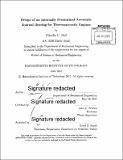| dc.contributor.advisor | John G. Brisson. | en_US |
| dc.contributor.author | Hail, Claudio U | en_US |
| dc.contributor.other | Massachusetts Institute of Technology. Department of Mechanical Engineering. | en_US |
| dc.date.accessioned | 2015-12-03T20:55:17Z | |
| dc.date.available | 2015-12-03T20:55:17Z | |
| dc.date.copyright | 2015 | en_US |
| dc.date.issued | 2015 | en_US |
| dc.identifier.uri | http://hdl.handle.net/1721.1/100130 | |
| dc.description | Thesis: S.M., Massachusetts Institute of Technology, Department of Mechanical Engineering, 2015. | en_US |
| dc.description | Cataloged from PDF version of thesis. | en_US |
| dc.description | Includes bibliographical references (pages 207-216). | en_US |
| dc.description.abstract | In this study an aerostatic journal bearing for reciprocating free pistons was designed for application with thermoacoustic engines. By taking advantage of the maxima and minima of the oscillating pressures inside the engine's cavity, the bearing does not rely on external pressurization by a pump, but is internally pressurized. The fluid film lubricated bearing is established by the continuous flow of gas in the clearance gap from a high pressure reservoir that is charged with gas from the engine's cavity to low pressure reservoirs that are drained to the engine's cavity both inside the engine's piston. A numerical model of this bearing is developed based on a laminar first order resistance-capacitance flow network of the flow in the bearing channels and clearance gap. This model was used to make design decisions and allowed to predict the pressures in the clearance gap and reservoirs and the performance of the bearing. In addition to the gas bearing for the radial suspension, a centering mechanism is integrated in the design to ensure an axially centered oscillation of the piston. This mechanism is first studied separately from the gas bearing using a numerical modeling, which was then validated in experiments with a piston in a cylinder resonating between two gas springs in sliding contact without including a gas bearing. For the validation of the gas bearing, an experimental set-up was built based on a multipiece hollow graphite free piston resonating in a closely fitted glass cylinder between two gas springs on a shaker table at 56.5 Hz. By measuring the axial, radial and circumferential piston displacement and the pressures in the gas springs and the piston's reservoirs the working principle of the bearing is investigated. The measured pressurization of the bearing's reservoirs, the radial centering and the significant reduction in mechanical friction represent a successful proof of concept of the gas bearing. At the operating conditions of a thermoacoustic power converter and with an improved design it is expected that a bearing load capacity of more than 20 N is feasible. Furthermore, a design of a thermoacoustic power converter including the gas bearing, a thermoacoustic engine and an electro-acoustic transducer is presented. | en_US |
| dc.description.statementofresponsibility | by Claudio U. Hail. | en_US |
| dc.format.extent | 216 pages | en_US |
| dc.language.iso | eng | en_US |
| dc.publisher | Massachusetts Institute of Technology | en_US |
| dc.rights | M.I.T. theses are protected by copyright. They may be viewed from this source for any purpose, but reproduction or distribution in any format is prohibited without written permission. See provided URL for inquiries about permission. | en_US |
| dc.rights.uri | http://dspace.mit.edu/handle/1721.1/7582 | en_US |
| dc.subject | Mechanical Engineering. | en_US |
| dc.title | Design of an internally pressurized aerostatic journal bearing for thermoacoustic engines | en_US |
| dc.type | Thesis | en_US |
| dc.description.degree | S.M. | en_US |
| dc.contributor.department | Massachusetts Institute of Technology. Department of Mechanical Engineering | |
| dc.identifier.oclc | 929672885 | en_US |
